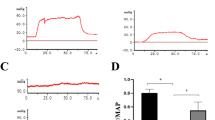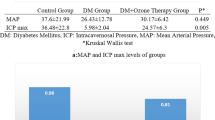Abstract
Recently, hydrogen sulfide (H2S) has been identified as a potential therapy for ED. However, a thorough understanding of its molecular mechanisms of action would be essential to develop H2S as a new therapy for ED. In this study, the effect of H2S on nitric oxide (NO) production, especially through the expression of constitutive nitric oxide synthase (NOS) isoforms—endothelial NOS (eNOS) and neuronal NOS (nNOS) in rat corpus cavernosum (CC) were explored. Real-time PCR studies subsequent to in vitro treatment of sodium hydrosulfide hydrate (NaHS), a stable H2S donor, showed increases in eNOS but not nNOS mRNA. Western blot studies confirmed that the exogenously applied NaHS increased eNOS but not nNOS protein expression in the rat CC. Furthermore, NaHS did not alter the expressed amounts of Caveolin-1 (CAV-1), a dominant inhibitory interaction partner of eNOS, in these tissues. Not surprisingly, NaHS also enhanced the NO production in eNOS-associated membrane fraction of rat CC. Taken together, we ascertain that H2S could exert its proerectile effects by augmenting NO pathway. It appears that H2S would be particularly useful in improving the clinical outcome of ED patients, whose erectile impairment is due to an inherent attenuation of the endothelial NO formation in the cavernosum.
This is a preview of subscription content, access via your institution
Access options
Subscribe to this journal
Receive 8 print issues and online access
$259.00 per year
only $32.38 per issue
Buy this article
- Purchase on Springer Link
- Instant access to full article PDF
Prices may be subject to local taxes which are calculated during checkout




Similar content being viewed by others
References
Li L, Moore PK . Putative biological roles of hydrogen sulfide in health and disease: a breath of not so fresh air? Trends Pharmacol Sci 2008; 29: 84–90.
Wang R . Hydrogen sulfide: a new EDRF. Kidney Int 2009; 76: 700–704.
Yang G, Wu L, Jiang B, Yang W, Qi J, Cao K et al. H2S as a physiologic vasorelaxant: hypertension in mice with deletion of cystathionine gamma-lyase. Science 2008; 322: 587–590.
Yang G, Wu L, Wang R . Pro-apoptotic effect of endogenous H2S on human aorta smooth muscle cells. FASEB J 2006; 20: 553–555.
Zhao W, Zhang J, Lu Y, Wang R . The vasorelaxant effect of H(2)S as a novel endogenous gaseous K(ATP) channel opener. EMBO J 2001; 20: 6008–6016.
Srilatha B, Adaikan PG, Moore PK . Possible role for the novel gasotransmitter hydrogen sulphide in erectile dysfunction—a pilot study. Eur J Pharmacol 2006; 535: 280–282.
d’Emmanuele di Villa Bianca R, Sorrentino R, Maffia P, Mirone V, Imbimbo C, Fusco F et al. Hydrogen sulfide as a mediator of human corpus cavernosum smooth-muscle relaxation. Proc Natl Acad Sci USA 2009; 106: 4513–4518.
Srilatha B, Adaikan PG, Li L, Moore PK . Hydrogen sulphide: a novel endogenous gasotransmitter facilitates erectile function. J Sex Med 2007; 4: 1304–1311.
Tang G, Wu L, Liang W, Wang R . Direct stimulation of K(ATP) channels by exogenous and endogenous hydrogen sulfide in vascular smooth muscle cells. Mol Pharmacol 2005; 68: 1757–1764.
Papapetropoulos A, Pyriochou A, Altaany Z, Yang G, Marazioti A, Zhou Z et al. Hydrogen sulfide is an endogenous stimulator of angiogenesis. Proc Natl Acad Sci USA 2009; 106: 21972–21977.
Duran WN, Breslin JW, Sanchez FA . The NO cascade, eNOS location, and microvascular permeability. Cardiovasc Res 2010; 87: 254–261.
Toda N, Ayajiki K, Okamura T . Nitric oxide and penile erectile function. Pharmacol Ther 2005; 106: 233–266.
Palit V, Eardley I . An update on new oral PDE5 inhibitors for the treatment of erectile dysfunction. Nat Rev Urol 2010; 7: 603–609.
Burnett AL . Erectile dysfunction. J Urol 2006; 175 (3 Pt 2): S25–S31.
Whiteman M, Li L, Rose P, Tan CH, Parkinson DB, Moore PK . The effect of hydrogen sulfide donors on lipopolysaccharide-induced formation of inflammatory mediators in macrophages. Antioxid Redox Signal 2010; 12: 1147–1154.
Ghigo D, Riganti C, Gazzano E, Costamagna C, Bosia A . Cycling of NADPH by glucose 6-phosphate dehydrogenase optimizes the spectrophotometric assay of nitric oxide synthase activity in cell lysates. Nitric Oxide 2006; 15: 148–153.
Parat MO, Fox PL . Palmitoylation of caveolin-1 in endothelial cells is post-translational but irreversible. J Biol Chem 2001; 276: 15776–15782.
Michel JB, Feron O, Sase K, Prabhakar P, Michel T . Caveolin versus calmodulin. Counterbalancing allosteric modulators of endothelial nitric oxide synthase. J Biol Chem 1997; 272: 25907–25912.
Chitaley K, Kupelian V, Subak L, Wessells H . Diabetes, obesity and erectile dysfunction: field overview and research priorities. J Urol 2009; 182 (6 Suppl): S45–S50.
Angulo J, Cuevas P, Fernandez A, Gabancho S, Allona A, Martin-Morales A et al. Diabetes impairs endothelium-dependent relaxation of human penile vascular tissues mediated by NO and EDHF. Biochem Biophys Res Commun 2003; 312: 1202–1208.
Bivalacqua TJ, Champion HC, Usta MF, Cellek S, Chitaley K, Webb RC et al. RhoA/Rho-kinase suppresses endothelial nitric oxide synthase in the penis: a mechanism for diabetes-associated erectile dysfunction. Proc Natl Acad Sci USA 2004; 101: 9121–9126.
Bivalacqua TJ, Musicki B, Usta MF, Champion HC, Kadowitz PJ, Burnett AL et al. Endothelial nitric oxide synthase gene therapy for erectile dysfunction. Curr Pharm Des 2005; 11: 4059–4067.
Cai WJ, Wang MJ, Moore PK, Jin HM, Yao T, Zhu YC . The novel proangiogenic effect of hydrogen sulfide is dependent on Akt phosphorylation. Cardiovasc Res 2007; 76: 29–40.
Acknowledgements
The authors wish to acknowledge the award of the research grant R-174-000-128-213 by the National Medical Research Council, Ministry of Health, Singapore for the conduct of this work. The technical assistance provided by Ms Roeswita Leono Liaw is duly appreciated.
Author information
Authors and Affiliations
Corresponding author
Ethics declarations
Competing interests
The authors declare no conflict of interest.
Additional information
Supplementary Information accompanies the paper on International Journal of Impotence Research website
Supplementary information
Rights and permissions
About this article
Cite this article
Meng, J., Ganesan Adaikan, P. & Srilatha, B. Hydrogen sulfide promotes nitric oxide production in corpus cavernosum by enhancing expression of endothelial nitric oxide synthase. Int J Impot Res 25, 86–90 (2013). https://doi.org/10.1038/ijir.2012.39
Received:
Revised:
Accepted:
Published:
Issue Date:
DOI: https://doi.org/10.1038/ijir.2012.39
Keywords
This article is cited by
-
Cavernosal hydrogen sulfide levels are associated with nitric oxide and hemeoxygenase levels in diabetic rats
International Journal of Impotence Research (2019)
-
Hydrogen sulfide treatment reduces blood pressure and oxidative stress in angiotensin II-induced hypertensive mice
Hypertension Research (2015)



